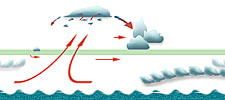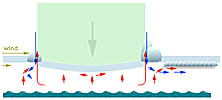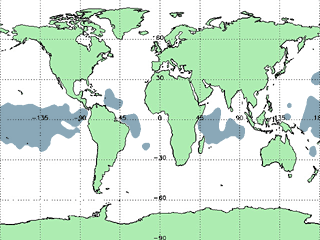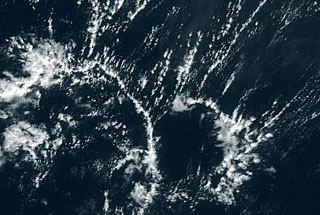
"Peacock Feather" Cloud Structure (PFCS)
The clouds of this structure often look from above like the parts of peacock’s feather or also like cacti of the kind “Opuntia ovata”.
These are round, oval or arc-like cloud forms or cloud series (with the cloud top height up to 3, rarely 3.5km), connected with each other and mixing with cloud lines often in the form of sea-grass (cloud top height 1.5-2km).
Most frequently they are to be observed above equator into so called “Kiritimati Cloud Province” (KLP-area).
Strictly speaking, this structure characterizes the province.
Regarding of cloud streets, which are often observed above the Tropics, the arc-like cloud forms are integrated into fields of cloud streets (type 1).
Not rare a cloud circle (oval or larger area) can be itself a source of cloud lines (type 2).
The reason for the emergence of this structure is not completely clear.
 It can be assumed that in the centre of Pacific above equator the inversion layer lies rather low, so that its location supports the formation of convective cloud streets. It can be assumed that in the centre of Pacific above equator the inversion layer lies rather low, so that its location supports the formation of convective cloud streets.
The temperature of the sea surface in the area is high and not everywhere the same, which can lead to the emergence of “Cloud Arc” structures.
Cooperation both structure could form the type 1 of the PFCS.
 A highly lying local high pressure area with relatively cold air can occur above the low lying inversion layer. The air flows from the sea surface, rises upward at the edge of this area, break through the inversion layer and cools down. A highly lying local high pressure area with relatively cold air can occur above the low lying inversion layer. The air flows from the sea surface, rises upward at the edge of this area, break through the inversion layer and cools down.
The clouds emerge.
The cold air flows from the high pressure area in the opposite direction. If it contacts with warm air, it promotes still stronger cloud emergence and creates conditions for the emergence of “cloud streets”.
This could be an explanation for emergence of the type 2.
The structure was observed
- everywhere over equatorial Pacific,
- also over Atlantic near to east Brazilian coast and over Antilles,
- over the Indian Ocean it can be seen close to the east African coast and Madagascar.
|

